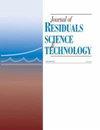微波辅助碳热法从倾倒铜渣中分离、回收铁、铜、锌
Journal of Residuals Science & Technology
Pub Date : 2016-01-01
DOI:10.12783/ISSN.1544-8053/13/2/S22
引用次数: 8
摘要
采用碳热法在微波照射下对铜渣中的铁、铜、锌进行分离和回收。铁在渣中以铁沸石和磁铁矿的形式还原为金属铁,锌则被蒸发成氧化锌粉。结果表明,新工艺的铁金属化率可达91.38~93.45 wt%,锌回收率为90.5 wt%,反应温度比传统工艺低100℃,反应时间缩短90 min。本文章由计算机程序翻译,如有差异,请以英文原文为准。
Separating and Recycling of Fe, Cu, Zn from Dumped Copper Slag by Microwave IrradiationAssisted Carbothermic Method
Iron, copper and zinc were separated and recycled from dumped copper slag using a carbothermic method in the presence of microwave irradiation. Iron in the form of fayalite and magnetite in the slag was reduced to metal iron while zinc was evaporated and captured as zinc oxide powder. Results indicated that metallization rate of iron could reach 91.38~93.45 wt% and zinc recovery efficiency was 90.5 wt% when the new methodology was employed, and that reaction temperature was 100°C lower compared to that of traditional processes, reaction time of the new process was decreased by 90 min.
求助全文
通过发布文献求助,成功后即可免费获取论文全文。
去求助
来源期刊

Journal of Residuals Science & Technology
环境科学-工程:环境
自引率
0.00%
发文量
0
审稿时长
>36 weeks
期刊介绍:
The international Journal of Residuals Science & Technology (JRST) is a blind-refereed quarterly devoted to conscientious analysis and commentary regarding significant environmental sciences-oriented research and technical management of residuals in the environment. The journal provides a forum for scientific investigations addressing contamination within environmental media of air, water, soil, and biota and also offers studies exploring source, fate, transport, and ecological effects of environmental contamination.
 求助内容:
求助内容: 应助结果提醒方式:
应助结果提醒方式:


